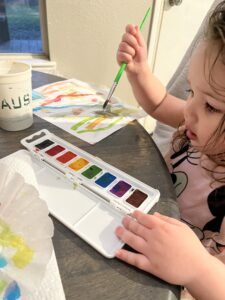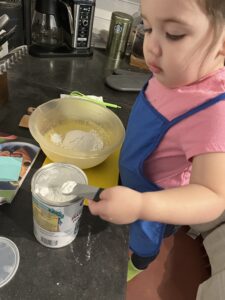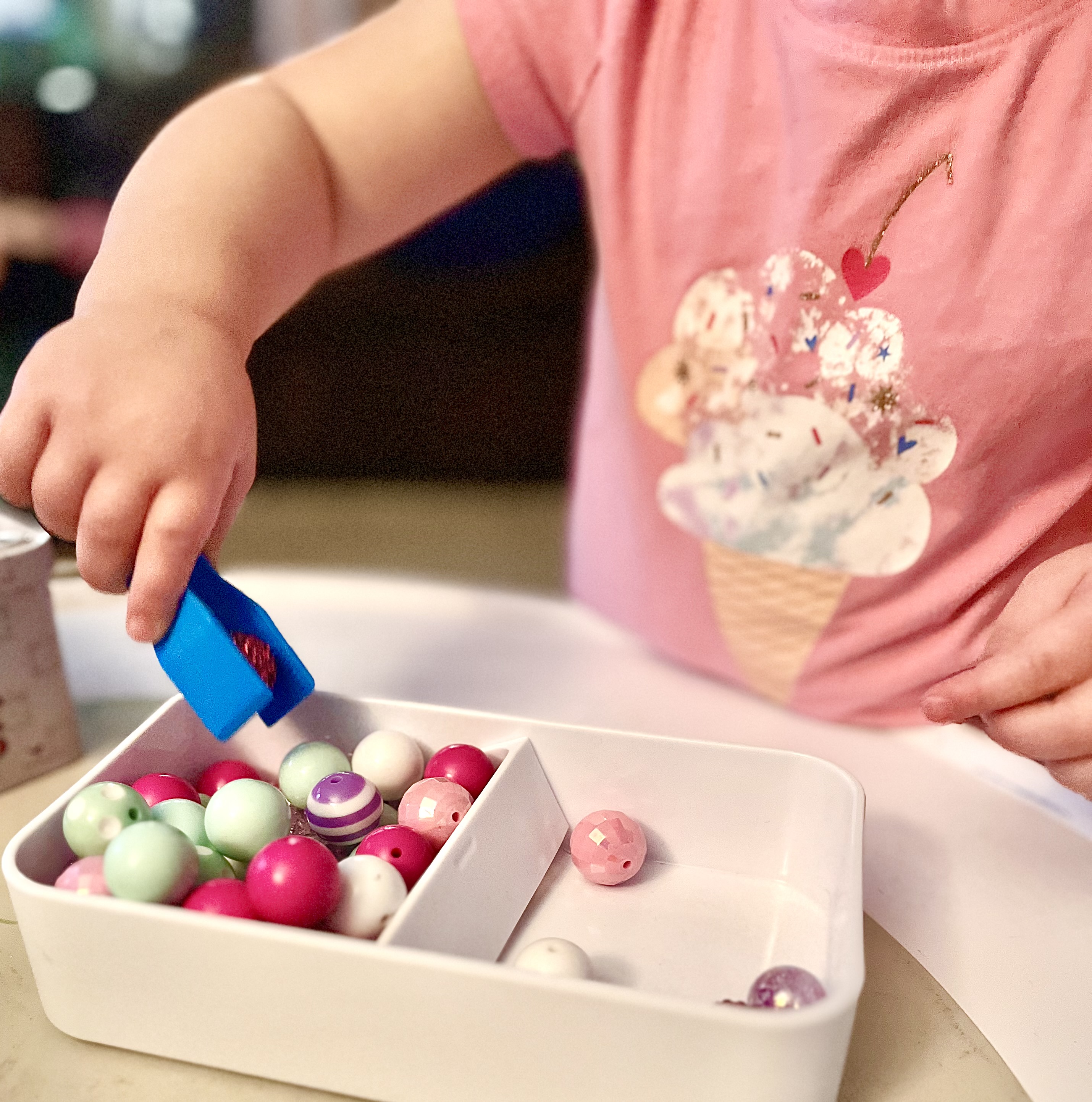This week, I am working on a lesson plan for one of my daughter’s favorite things…the kitchen. As my kitchen helper, Evie is often tasked with pouring ingredients into a bowl, stirring batters, and believe it or not cutting some fruits and veggies, with supervision. These activities take a great deal of fine motor skills in order to properly do. In order to practice developing these skills, my daughter and I often do fine motor skill activities throughout the day to build her little hand muscles!
If a toddler in the kitchen terrifies you like it used to terrify me, check out my post about toddler kitchen safety and see how I went from a nervous wreck to trusting my daughter with knives.
In this post, I have compiled a list of activities that Evie and I love doing and are wonderful for building fine motor skills for toddlers and preschoolers.
Why You Should Be Doing Fine Motor Skill Activities with Your Toddler/Preschooler
A fine motor skill is the ability to control smaller movements. Think along the lines of pouring milk into a cup, tying shoes, and writing. Without these skills, doing daily tasks, like putting clothing on, would become much more difficult to do.
Developing fine motor skills is important when children begin to write. Without these fine motor skills and muscle development in their hands, they may struggle to write when it is introduced in school.
One study found that hand-eye coordination, left-to-right hand coordination were both significantly improved with educationally play. So, PLAY, PLAY, PLAY!
This article lists several more activities you can do with your child and gives you great background information about fine motor skills in preschool.
Fine Motor Skill Activities to Do at Home with Your Toddler/Preschooler
This post may contain affiliate links, which means I’ll receive a commission if you purchase through my links, at no extra cost to you. Please read full disclosure for more information.
Pinching/Tongs
Tong/Tweezer activities are my favorite. Not only is Evie building those hand muscles, she’s also practicing her hand-eye coordination. Using tongs or tweezers have your child practice transferring items from one container to another. Today, Evie found my stash of large beads. She LOVES these beads, probably because I don’t bring them out all that often. Part of me is worried that she might actually try to eat one instead of pretending to eat one. The other part of me is worried that she will try to feed them to our dogs. It is safe to say when those beads come out, I’m actively participating in whatever game she is playing. This morning we used the tongs to grab the bead and transfer them from one container to another. You could see her improvement as we continued. You could also see when her hands started to get tired as she started grabbing them with her other hand.
To do this activity, you do not need to have large beads. You can use
- Beans
- Sorting dinosaurs (if your toddler/preschooler loves dinosaurs try this morning basket!)
- Easter eggs
- Rice and tweezers (if you want to give a more advanced child a challenge)
- Pom poms
- Cotton balls
Lacing Activities
This is another great fine motor skill activity as well as a hand-eye coordination activity. The beads were used multiple times today and I LOVED it! Personally, I’d rather not by a million single use toys, I’d rather by things that are versatile and can be used in multiple different ways. Anyways, I’m off topic. For this lacing activity, I used beads and pipe cleaners. Don’t ask me why I have a massive bag of pipe cleaners at my house. Between you and me, I have a small crafting problem.
Evie practiced stringing the beads onto the pipe cleaner, as an added bonus we counted the beads too! However, if you don’t have beads and pipe cleaners, cheerios and string/yarn is a good alternative (especially if your little likes to put things in their mouth).
Painting/Drawing
Practicing painting and drawing is a great way to practice fine motor skills. Gripping a pencil/crayon/marker/paint brush utilizes a lot of muscles in those tiny hands. These activities help children develop their prewriting skills and are a critical part of their development as an emergent writer. When Evie uses her art easel to draw or paint, I stay close by to help her adjust her grip. The art easel is great for supporting their wrist during this transition. It is common for children to be uncomfortable during the initial switch from a fist hold to a three-finger hold, the more they practice and the more they build those muscles the easier it will be for them later on.

Peeling Stickers
My child LOVES stickers. I’m sure this isn’t an uncommon thing. The good news is that peeling stickers off of the paper is a wonderful fine motor skill activity. The best part is it super simple. I like to challenge Evie a little more, so on a blank piece of computer paper, I draw a letter (E for Evie, we have the added bonus of practicing our letter recognition here) with circles along the lines. Evie tries to place her stickers to cover the circles on the line. It like sticker target practice!
Pouring/Measuring
This is one activity (cough* chore cough*) that Evie loves to do. Every morning Evie is in charge of scooping dog food into bowls for her puppies. This helps her build strong muscles in her wrist and helps her be “slow and gentle” while pouring the food into the bowls.
She is also my little kitchen helper. Any time we cook or bake, she helps me measure out my ingredients. If you plan on having your child help you in the kitchen, please remember to practice kitchen safety with your toddler!

However, if your little isn’t quite ready to be a kitchen helper, there are other easy ways to practice pouring or measuring. You can create a sensory bin with oats, corn, flour, dirt or whatever else you want to introduce to your child. Then add some measuring cups and get scooping!
Need some sensory bin ideas? Check out these Easter themed sensory bins!
Fine motor skills are an essential part of life! Developing and practicing these fine motor skills will help your children grow and accomplish tasks independently. They can even help develop good hand-eye coordination later in life. Do you have favorite fine motor skills activities that you do with your children at home? I would love to hear about them!

